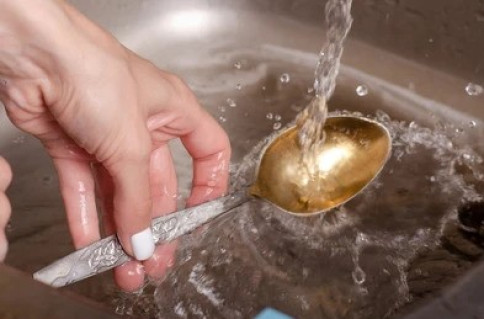- How to Wash a Spoon Without Splashing: A Quick Guide

The simple act of washing a spoon can often turn into a water ballet of unintended proportions. Those pesky splashes can leave your kitchen counter, clothes, and even your face feeling the brunt of your dishwashing efforts. But fear not, with a few strategic adjustments, you can transform this mundane task into a splash-free zone.
Understanding the Science of Splashing
To effectively combat splashing, it's essential to understand the mechanics behind it. Water droplets form when the surface tension of the water is disrupted. This typically occurs when water collides with an object at high velocity or with a large surface area. In the case of a spoon, the bowl of the spoon creates a significant surface area for the water to impact, resulting in those pesky splashes.
Mastering the Art of Splash-Free Spoon Washing
-
Control the Water Flow:
- Gentle Stream: Reduce the water pressure to a gentle, steady flow. A forceful jet of water is the primary culprit behind splashing.
- Single Stream: Focus the water flow into a single, concentrated stream rather than a wide, dispersed spray.
-
Optimize Spoon Angle:
- Downward Angle: Hold the spoon at an angle, with the bowl facing downwards. This minimizes the surface area exposed to the water, reducing the chances of splashing.
- Gentle Movements: Avoid abrupt or jerky motions. Smooth, controlled movements will help prevent water from splashing.
-
Leverage Dishwashing Detergent:
- Foam Factor: Use a dishwashing liquid that produces ample foam. The foam acts as a barrier, absorbing the impact of the water and reducing splashing.
- Soapy Solution: Create a soapy solution in the sink and submerge the spoon before rinsing. This can help break down food particles and reduce the need for forceful water.
-
Utilize Dishwashing Tools:
- Sponge or Cloth: Employ a soft sponge or cloth to gently clean the spoon. This can help to absorb excess water and prevent splashing.
- Dish Brush: For stubborn residue, a dish brush can effectively clean the spoon without excessive water use.
-
Drying Techniques:
- Immediate Drying: Dry the spoon promptly with a clean dish towel to prevent water droplets from forming and splashing.
- Air Dry: If time permits, allow the spoon to air dry on a dish rack, ensuring it's placed upside down to prevent water accumulation.
Additional Tips for a Splash-Free Kitchen
- Sink Size: A larger sink provides more space to maneuver dishes, reducing the likelihood of accidental splashes.
- Rubber Gloves: Wearing rubber gloves can protect your hands and arms from unexpected water droplets.
- Pre-Rinse: For heavily soiled spoons, consider pre-rinsing them under running water to remove large food particles before washing.
By incorporating these techniques into your dishwashing routine, you can significantly reduce splashing and create a more enjoyable cleaning experience. Remember, practice makes perfect, so experiment with different methods to find what works best for you.
With a little patience and practice, you'll be a splash-free dishwashing pro in no time!

















